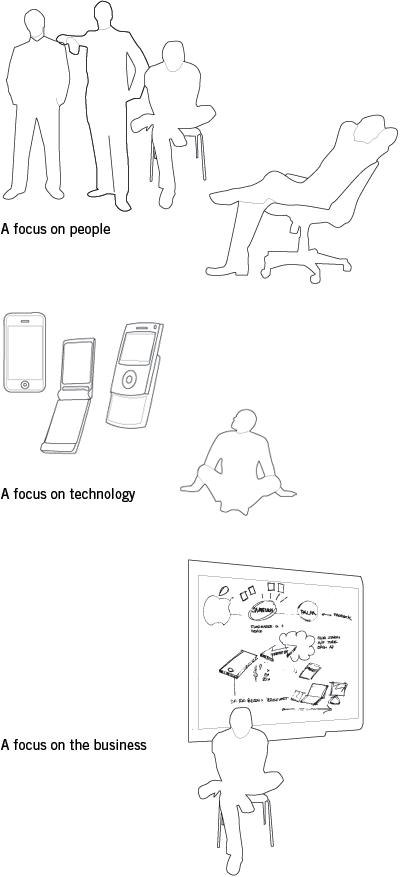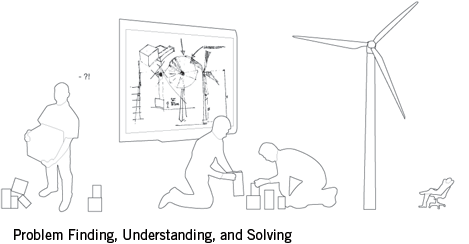Design research is different from marketing research. The goal in design research is to find inspiration for design, whereas the goal in marketing research is to predict the behavior of a larger group. Unfortunately, large businesses nearly always lose this critical distinction in the similar terminology and approaches. Consider the core similarities and distinctions listed in Table 4.1.
| Design Research | Marketing Research |
|---|---|
Focuses on people |
Focuses on people |
Can be qualitative or quantitative |
Can be qualitative or quantitative |
Borrows from the social and behavioral sciences |
Borrows from the social and behavioral sciences |
Attempts to understand culture. Looks at the styles, words, tools, and workarounds people use in an effort to inspire design. |
Attempts to predict behavior. Looks at what people say they would do, or what they actually do, in an effort to predict what they would do in a new situation. |
Celebrates the unique and peculiar. The rare or obscure in observations can lead to a new or interesting design idea. |
Avoids the unique and peculiar. The goal is to understand mass responses; outliers are frequently ignored. |
Avoiding bias is irrelevant. The goal is not to be objective but instead to be rigorous. |
Avoiding bias is critical. The statistical analyses of data require an objective point of view. |
To witness the ambiguity about research in the context of a business problem, consider the real-world example that follows:
A design team is writing a proposal for a $200,000, 12-week program to develop innovative digital-file storage. A third of the time will be spent conducting research, and the team decides to observe how eight people work and document that research through transcription. From this research, the team will produce a list of key insights and use those insights to generate preliminary design ideas. When the designer presents the proposal to the client, the following dialogue occurs:
Prospective Client: “So, I see here that 4 weeks—or about $65,000—is going to research. We’ve already done a lot of research. We have a great document that we can give you. It’s about 60 pages long with lots of charts and graphs. It describes the segments we are targeting and has responses to a great survey we conducted with thousands of people. So let’s take this section out completely.”
Creative Director: “Although your document sounds very interesting, the type of research we do is different. We will look for some of the nuances in the work environment, learn about the culture of digital storage in the workplace, and really get to know how people think about digital file storage.”
Prospective Client: “Your proposal shows you’re only going to look at eight people, though. We’ve done a questionnaire with thousands of online respondents, so we feel pretty confident that we know what people want.”
Creative Director: “Understood, but it’s a really critical part of our process.”
Prospective Client: “I would really like to see this proposal rewritten without that $65,000 in it.”
Both sides are right, but they are right about different things. The client’s questionnaire data—if it was collected properly—can indicate a set of statistically relevant predictions about what a larger population might do. But this data will not describe what to make, how to make it, or what the interactions and experiences should feel like. Because both sets of activities are called research, the client is quick to dismiss this seemingly duplicative work as a waste of time and money. Then the designer’s difficult job becomes to educate and evangelize the unique role of design research. Designers may succeed in educating the client by showing samples from previous projects (and highlighting how research was conducted) and will sometimes show diagrammatic representations of how the research data will be transformed directly into the final product.
An unfortunate side effect of this dialogue is that unless the education succeeds, the designer will likely still conduct the research but will not charge for it. This will diminish the value of design research on that particular project and, over time, design research as a whole.
Jan Chipchase, a design researcher at frog design, commonly conducts research without a particular project or product in mind (and frequently without the challenges of the evangelizing described earlier). Chipchase was asked by frog to travel the world, observing people and their communication behavior. He was not looking at traditional usability, such as the “ease of use” of specific products or the number of taps it takes to dial a number. Nor was he focused on marketing metrics or the search for “innovation” or “insight.” Instead, Chipchase worked to understand how communication fits into culture, be it augmented by technology like a cell phone or facilitated by a human mechanism like dance, speech, or writing.
Whether the research is pragmatic—as in looking for usability enhancements—or conceptual—as it was for Chipchase—the philosophy of design research is the same: to learn from people and to emphasize people, rather than technology or business. As an example, consider a design-research program focused on understanding the social relationships between teens and mobility. A researcher could approach this problem from three immersion perspectives by immersing herself in the following:
- A group of teens who frequently travel a great deal or commute to school and then to their jobs. The researcher would try to understand the way teens keep in touch over distances, and she would learn about the language and the feelings about staying in touch over distances.
- The technology used by teens, by looking at their various computers, phones, and other technological devices. The researcher would try to understand the pros and cons of various existing tools, and she would learn about the attitudes toward these devices, the most and least frequently used features, and the qualitative feelings about the various tools.
- The business of mobile communication and networking, by looking at the services and capabilities of leading companies such as Facebook or AT&T. The researcher would learn about pricing models, tiered offerings, branded services, and the other packages.
In the first perspective, the researcher will learn about potential for the future state. She will see problems as opportunities, and findings will emphasize behavior. Behavioral opportunities may exist in the following areas:
- Technology (the devices the teens own)
- Style (the clothing the teens wear)
- Identity (the language the teens use)
- Infrastructure (the transportation methods the teens use)
This perspective is broad. The researcher can learn about the topic from a holistic sense, looking both directly at the problem of “social relationships and mobility,” as well as around the problem.
In the second perspective, the researcher will learn about the current state, from a realistic standpoint. The word realistic implies that the artifacts being investigated have conformed to the realities of production. Their constraints are usually pragmatic. (“At the date of production, a smaller phone could not fit all of these electronics. No matter how much we want it to be smaller, it cannot be.”) The researcher will gain a great deal of knowledge around the following areas:
- Usability of existing software, hardware, and services
- Frequency of use of existing software, hardware, and services
- Emotional resonance of existing software, hardware, and services
This is useful information, particularly when attempting to fix and refine an existing solution with a “follow-on” release. The perspective is narrow because the researcher focuses on particular devices and the software functionality afforded by those devices.
In the third perspective, the researcher will learn implicitly about the current state, from a subjective standpoint. A particular service is offered for free or for a cost because a business decided it would be so. (“We can offer this service for free in order to build brand equity, which is worth more to us than the amount we could have made from charging for the service itself.”) The researcher will be able to gain a great deal of knowledge around the following areas:
- Pricing, feature, and service structures other companies have deemed important
- The way various artifacts, services, and systems have been positioned in the marketplace
- The elements that have become ubiquitous to a particular business context
This is useful information when attempting to package and sell an already designed product, service, or system. The perspective is narrow. The researcher focuses on particular pricing structures, service offerings, and capability models from various competitors.

Each of these research methods focuses on a different aspect of an artifact, yet only the first—focusing on human behavior—emphasizes opportunity and potential. A focus on technology or product is destined to be constrained by realism ([for example], What can we do, given current abilities?). A focus on business or market is destined to be constrained by precedent ([for example], What are others doing, and how are they doing it?). In this way, design research that focuses on human behavior in a broad sense—not on a particular object or service—is the most effective at discovering data for innovation.

